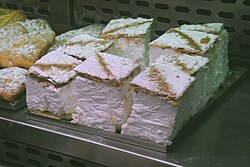
Puff pastry, also known as pâte feuilletée, is a flaky light pastry made from a laminated dough composed of dough and butter or other solid fat. The butter is put inside the dough, making a paton that is repeatedly folded and rolled out before baking.

An enchilada is a Mexican dish consisting of a corn tortilla rolled around a filling and covered with a savory sauce. Enchiladas can be filled with various ingredients, including meats, cheese, beans, potatoes, vegetables, or combinations. Enchilada sauces include chili-based sauces, such as salsa roja, various moles, tomatillo-based sauces, such as salsa verde, or cheese-based sauces, such as chile con queso.
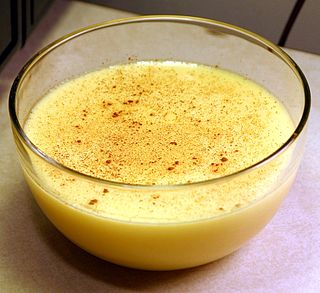
Custard is a variety of culinary preparations based on sweetened milk, cheese, or cream cooked with egg or egg yolk to thicken it, and sometimes also flour, corn starch, or gelatin. Depending on the recipe, custard may vary in consistency from a thin pouring sauce to the thick pastry cream used to fill éclairs. The most common custards are used in custard desserts or dessert sauces and typically include sugar and vanilla; however, savory custards are also found, e.g., in quiche.

Dough is a thick, malleable, sometimes elastic paste made from grains or from leguminous or chestnut crops. Dough is typically made by mixing flour with a small amount of water or other liquid and sometimes includes yeast or other leavening agents, as well as ingredients such as fats or flavorings.

Stargazy pie is a Cornish dish made of baked pilchards (sardines), along with eggs and potatoes, covered with a pastry crust. Although there are a few variations using other types of fish, the unique feature of stargazy pie is fish heads protruding through the crust, so that they appear to be gazing to the stars.

Christopher Richard Stein, is an English celebrity chef, restaurateur, writer and television presenter. Along with business partner Jill Stein, he runs the Stein hotel and restaurant business in the UK. The business has a number of renowned restaurants, shops and hotels in Padstow along with other restaurants in Marlborough, Winchester and Barnes. He is also the head chef and a co-owner of the "Rick Stein at Bannisters" restaurants in Mollymook and Port Stephens in Australia, with his second wife, Sarah. He writes cookery books and has presented numerous cookery series for the BBC.

A mille-feuille, also known by the names Napoleon in North America, vanilla slice in the United Kingdom, and custard slice, is a French dessert made of puff pastry layered with pastry cream. Its modern form was influenced by improvements made by Marie-Antoine Carême.

A layer cake or sandwich cake is a cake consisting of multiple stacked sheets of cake, held together by frosting or another type of filling, such as jam or other preserves. Most cake recipes can be adapted for layer cakes; butter cakes and sponge cakes are common choices. Frequently, the cake is covered with icing, but sometimes, the sides are left undecorated, so that the filling and the number of layers are visible.

Galaktoboureko is a Greek, Albanian, Laz, and Syrian dessert of semolina custard baked in filo. Lazi Laz böreği is made with a type of pudding called muhallebi instead of semolina custard. It is popular in Rize and Artvin provinces in Turkey's Black Sea Region, indigenous home of Laz people. In Albania it's a dessert traditionally prepared during the Orthodox Easter.

A cremeschnitte, also known as vanilla slice or custard slice, is a custard and chantilly cream cream cake dessert commonly associated with the former Austro-Hungarian Monarchy. However, its exact origin is unknown. This dish remains popular across Central Europe and the Balkans in various variations, all of which include a puff pastry base and custard cream.
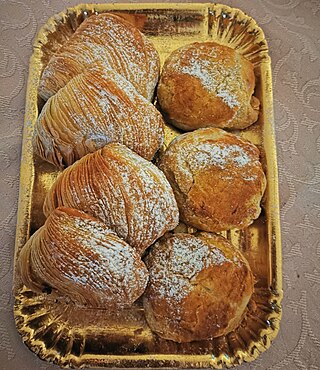
A sfogliatella, sometimes called a lobster tail in the US, is a shell-shaped filled Italian pastry originating from Campania. Sfogliatella means "small, thin leaf/layer", as the pastry's texture resembles stacked leaves.

Picadillo is a traditional dish in many Latin American countries including Mexico and Cuba as well as the Philippines. It is made with ground meat, tomatoes, and also raisins, olives, and other ingredients that vary by region. It is often served with rice or used as a filling in dishes such as tacos, savory pastries or croquettes. The name comes from the Spanish word picar, meaning "to mince".
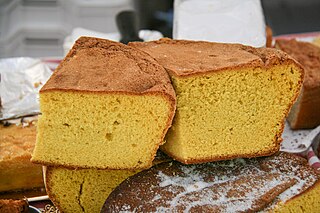
Bizcocho is the name given in the Spanish-speaking world to a wide range of pastries, cakes or cookies. The exact product to which the word bizcocho is applied varies widely depending on the region and country. For instance, in Spain bizcocho is exclusively used to refer to sponge cake. In Uruguay, most buttery flaky pastry including croissants are termed bizcocho, whilst sponge cake is called bizcochuelo. In Chile, the Dominican Republic and Bolivia bizcocho refers to a sweet dough (masa) baked with local ingredients, similar to the bizcocho from Spain. In Ecuador the dough of a bizcocho can either be sweet or salty. The US state New Mexico is unusual in using the diminutive form of the name, bizcochito, as the name for a locally developed and very popular cookie.

A Dominostein is a confection primarily sold during Christmas season in Germany and Austria.
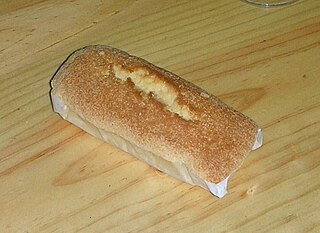
Mantecadas are spongy pastries originating in Spain. Perhaps the best known mantecadas are from Northwestern Spain, being a traditional product of the city of Astorga, province of León, as well as the nearby Maragateria comarca. They taste very much like pound cake.

A palmier, pig's ear, palm heart, or elephant ear is a French pastry in a palm leaf shape or a butterfly shape, sometimes called palm leaves, cœur de France, French hearts, shoe-soles, or glasses that was invented in the beginning of the 20th century.

Pan dulce, literally meaning "sweet bread", is the general name for a variety of Mexican pastries. They are inexpensive treats and are consumed at breakfast, merienda, or dinner.

Schaumrollen, or Schillerlocken, are an Austrian confection. They consist of a cone or tube of puff pastry filled with whipped cream or meringue. They are about 3 inches (7.6 cm) wide. The pastries are made by wrapping thin pastry strips around a cone shaped metal tube. After baking, they are filled with the "foam", which is usually sweetened whipped cream or meringue. The pastry tubes are often rolled in coarse sugar or powdered sugar before baking, for extra sweetness and a crunchy texture.

Snow puffies are a variation of a mille-feuille popularized by Paʻalaʻa Kai Bakery in Waialua. Snow puffies are a popular dessert in Hawaii often purchased as omiyage or recreated by home pastry chefs.
